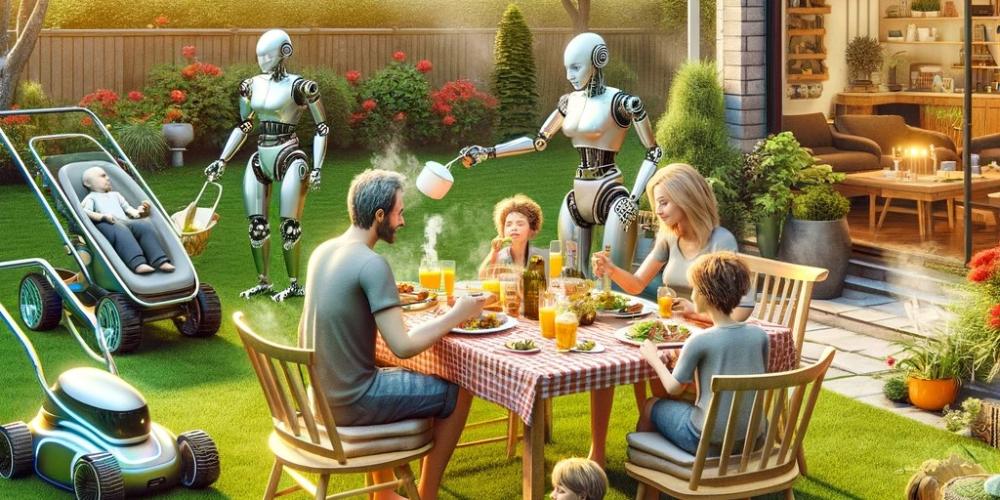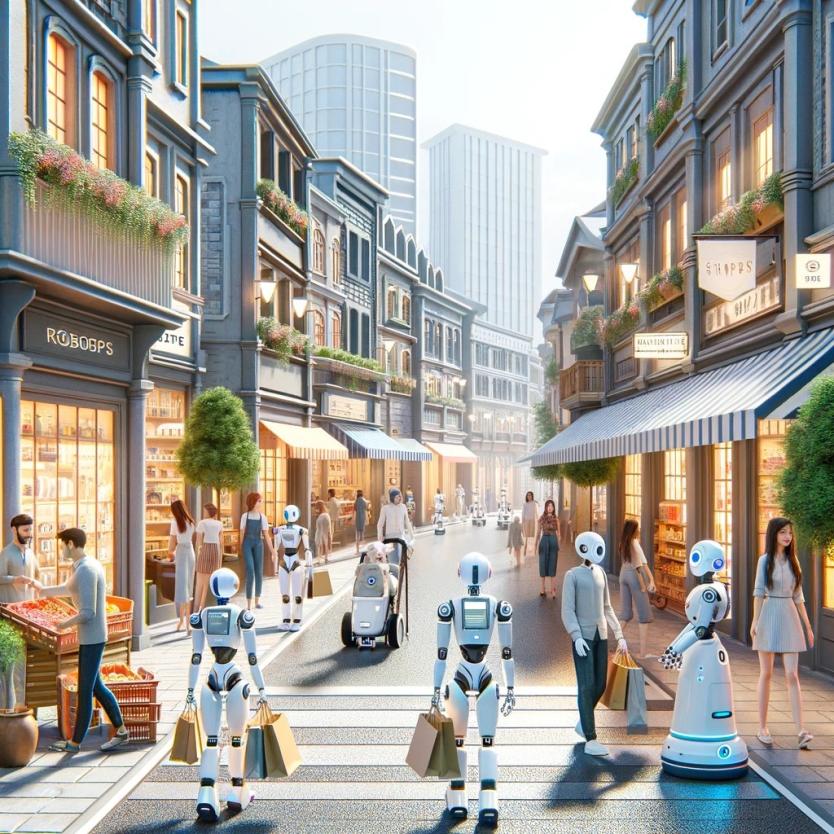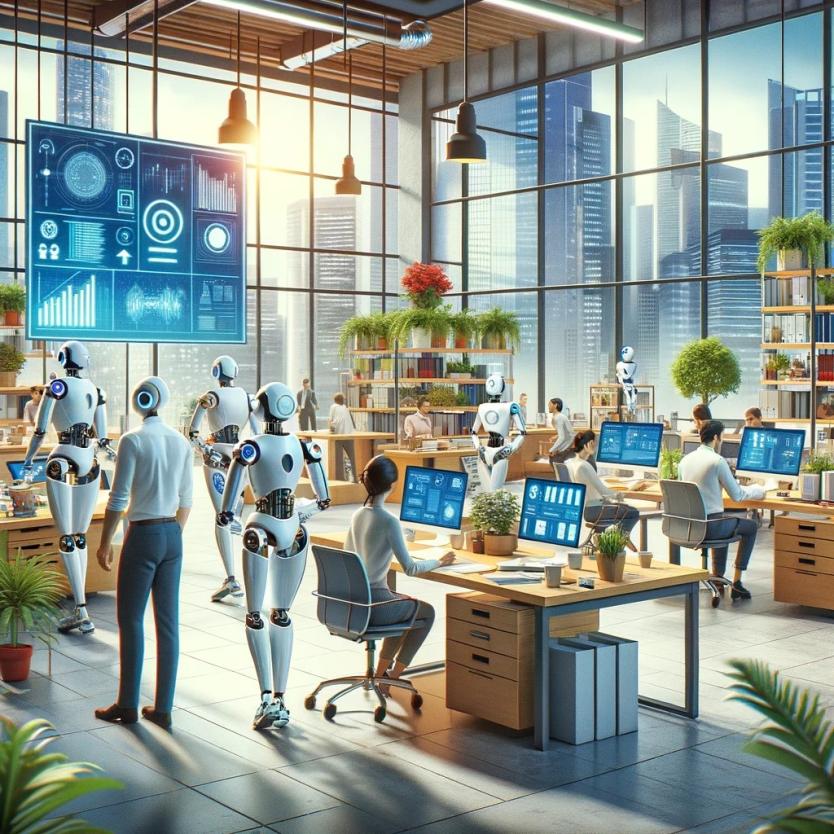
A household robot that vacuums, unloads the dishwasher, mows the lawn and drills a perfectly round hole in your wall? According to VUB professor Bram Vanderborght, that’s not science fiction. “With mass production, robots could become as affordable as an average car.”
Is Bram Vanderborght correct, or is he too optimistic? Mark Zuckerberg, Elon Musk and James Dyson seem to share his opinion. Their companies Meta, Tesla and Dyson are heavily investing in intelligent, AI-driven humanoid robots. For Vanderborght, though, these are still a thing of the future. The machine he rented over the weekend to dig trenches for plumbing in his garden refused to work, and there was no robot to lend a hand. “I can feel it in my back,” he laughs. “This kind of task is still beyond a robot’s capabilities. Technical work may seem easy and repetitive, but it requires more dexterity than one might think. Craftsmen don’t need to worry; lots of work will remain done by humans.

Bram Vanderborght
What are humans so good at?
Bram Vanderborght: “Humans have senses, brains and muscles that allow them to observe, explore and manipulate their environment. Robots must do the same but using sensors, processors and motors. Of course, our brains contain intelligence, but we also have ‘embodied intelligence’. Our bodies have evolved so we can walk through a forest or pick up a stick without thinking. The challenge is to design robots that can emulate these seemingly trivial tasks as closely as possible.”
Are AI algorithms increasingly used for this processing?
“Not exclusively. The dancing robots from Boston Dynamics, featured in the Do You Love Me? video on YouTube, don’t use AI. They operate on models based on Newton’s laws of motion, which describe the relationship between force and movement. From these, you can precisely calculate the forces needed to turn, jump or grasp an object. We call this model-based control. Outside the lab, this often isn’t enough because the real world is much more complex and unpredictable. Since we don’t have models for everything, AI
comes into play. Robots will combine the best of both worlds. A model-based foundation will ensure they don’t perform unsafe actions, like colliding with a person. An AI layer will allow them to learn new tasks.”
Is this AI like ChatGPT?
“ChatGPT is a large language model that learns from a vast array of texts. Data isn’t a big issue here since the internet is brimming with text. For communicating with robots, ChatGPT is relevant. People are also working on images and videos, which require huge amounts of data and computing power. For robot control, we need even more sensor data, while we often lack vast amounts of training data. Yet humans don’t need masses of data to learn. Children quickly recognise things. My son saw a balloon shaped like SpongeBob on the news. From the context, he immediately knew it was a balloon. AI might have just seen the cartoon character.”
“As robots navigate among people, safety becomes the highest priority”
Aren’t huge data and computing power demands unsustainable?
“That’s a challenge. The computers driving autonomous vehicles process a lot, hence they consume a lot of energy. Humanoid robots will have hundreds of sensors. The demand for computing power will skyrocket. We’ll need to develop new chips, sensors, hardware and software to reduce energy consumption.”
What other hurdles are there?
“Safety is the number one challenge. Learning to play chess on a computer or deploying a system like ChatGPT happens in a virtual world where mistakes are not critical. Robots, however, share our physical world, making safety an absolute priority. They must not harm people, their surroundings or themselves.”
Like self-driving cars sometimes do. Are those considered robots?
“A modern car is not entirely autonomous – even on autopilot, the driver must remain vigilant. But it does detect the environment and potential hazards using its sensors. In this sense, it is a robot, as is a drone. If you command a drone to move forward and it detects a wall, it will not execute the command. A model plane, however, can be crashed intentionally; it’s not a robot.”

Picture made by AI-tool DALL-E
“Robots could deliver meals and medication in care homes”
If we want robots to perform real-world tasks, what do we still need to invent?
“Sensors for tactile feedback. Seeing, hearing and talking are less of a problem. We can borrow technologies from other industries like gaming and telecoms. But tactile interaction – true physical interaction – is another matter. That technology will have to be developed by the robotics sector itself. Our skin is our largest organ, but for a robot, it’s currently little more than a plastic cover. We can pick up a pen, twirl it, let it slide through our fingers... Robots will need to do these kinds of things too. They require sensors that measure not just pressure but also friction or shear stress. The Belgian company Melexis is developing such 3D force sensors for robots – we have a joint project to incorporate them into robotics. And with imec, we’re developing a new sensor skin to measure distances, allowing robots to work much faster yet safely with people.”
It sounds like there’s still a long way to go
“Lots of humanoid robot companies were founded in 2023. We’re at the beginning of the Gartner Hype Cycle, which every new tech product goes through. The first phase is buzz around the innovation, followed by hype with inflated expectations. After the peak comes the trough of disillusionment: the technology is less revolutionary than hoped, and interest wanes. Next, realistic applications and practical implementations take over. Ultimately, the new technology often performs better than anticipated. We tend to overestimate the near future and underestimate the distant future. This was the case with mobile phones and AI, and it will be the same for self-driving cars and robots.”

Picture made by AI-tool DALL-E
Where do you see robots fitting into that distant future?
“In healthcare, hospitality, agriculture... anywhere there’s a shortage of people. But we must choose wisely what to automate. In a care home, a robot could move patients and deliver meals and medication, freeing up staff for human contact.”
“Robots will not steal jobs but will work with us"
They won’t take our jobs?
“We will work together. We complement each other: robots are more precise and don’t get tired, humans are more creative and dexterous.”
Can everyone afford a robot?
“Today, a humanoid robot is like a Ferrari: handcrafted and exorbitantly expensive. But with mass production, they’ll become as affordable as a regular car. That’s cheap when you consider the technology inside.”
Are Flanders and Europe ready for the robot revolution?
“Research gets a lot of support, but the leap to creating start-ups and businesses is vast because hardware development is so costly. Fortunately, Europe has large robot manufacturers like ABB, Siemens and Kuka, although Kuka has recently passed largely into Chinese hands. We must make the right choices now. Economically and geopolitically, it’s important to retain both design and production here. Elon Musk’s motto is well-known: design is overrated, manufacturing is underrated. The biggest innovation isn’t the Tesla, but the way it’s produced affordably. Let’s not make the same mistake as before: building knowledge here, only for the US or China to profit from it and create monopolies.”
What role does VUB play in this story?
“Our research group BruBotics coordinates several European research projects and launches spin-offs, with the aim of stimulating entrepreneurship. We also strive to contribute to the various aspects of the UN Sustainable Development Goals. It remains a big challenge.”
Bio Bram Vanderborght
Prof Bram Vanderborght, a VUB alumnus, studied mechanical engineering and became a professor at the age of 29. He is affiliated with nanotech research centre imec and is a member of BruBotics, the Brussels Human Robotics Research Center. This research group combines eight teams from VUB who conduct multidisciplinary research into human robotic technology. Their interdisciplinary collaboration, spanning from materials science and AI to human physiology and sociology, is unique.